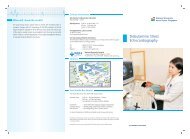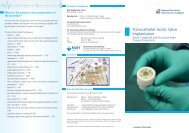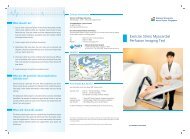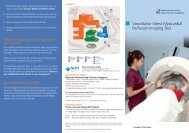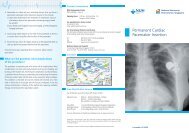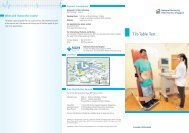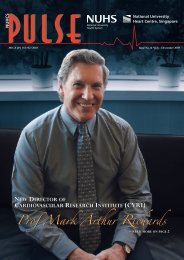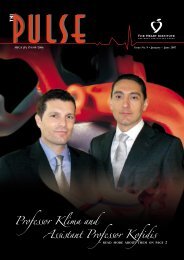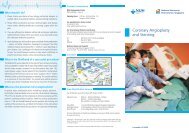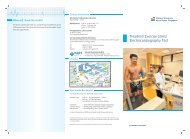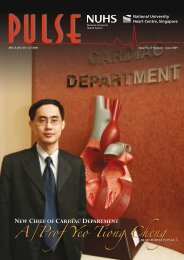2011 July - December - nuhcs
2011 July - December - nuhcs
2011 July - December - nuhcs
- No tags were found...
You also want an ePaper? Increase the reach of your titles
YUMPU automatically turns print PDFs into web optimized ePapers that Google loves.
Fortunately modern and available treatments for heart andvascular disease have resulted in improved survival and quality oflife. Great leaps in open cardiovascular surgery and cardio vascularinterventions have been made in parallel over the last 50 years.These include open heart surgery with cardiopulmonary bypass,heart valve replacement, coronary stenting, drug eluting stentsand endovascular aortic aneurysm repair. Some of these areas willbe covered further in this issue.Recently there has been convergence of these interventionstowards hybrid procedures that afford a minimally invasiveapproach by a combination of surgical operations with preciseimaging and endovascular techniques. Some examples are in theevolution of hybrid coronary revascularization, trans-catheteraortic valve implantation, endovascular aortic surgery andendovascular intervention for limb salvage. Several factors drivingthis convergence are an aging patient population, improved devicetechnology and better imaging. Patients with cardiovascular diseaserequiring treatment are increasingly elderly and consequently havesignificant morbidities and therefore tolerate these less invasiveoperations much better. Moreover the proportion of emergencyand complex cases that can be treated by a hybrid approach areincreasing. Device technology and imaging continue to evolverapidly. Endovascular devices can now be customized for diseasespecific anatomy and delivered in smaller systems. The needfor precision through better imaging will be paramount. Thesepatients are now best served by aminimimally invasive procedurein a safe and sterile environmentwith full anaesthetic supportand monitoring. A “Hybrid”operating room combines all thefeatures of a standard operatingroom with state of the artimaging. It’s a glimpse into thefuture of surgery and sets a newstandard of care for patients with cardiovascular disease.Multidisciplinary teams have also evolved to perform theseprocedures in a hybrid Operating Theatre (OT) environment withexcellent angiographic imaging with digital subtraction and 3-Dimaging for planning and navigation. At NUHCS these complexprocedures are performed by multidisciplinary teams comprisingcardiac and vascular surgeons, interventional cardiologists andradiologists as well as anaesthetists. The ideal hybrid OT shouldbe configured for flexible and ample working space with a fixedimaging system, a floating radiolucent OT table, laminar airflowenvironment for sterility and full anaesthetic support with heartlung bypass capability.The newly built hybrid cardiovascular OT at NUHCS featuresa state of the art Siemens Artis Zeego angiographic system. TheSiemens Artis Zeego, is a multi-axis system based on robotictechnology that can be positioned any way the operator wants andprovides cross-sectional, large volume 3D imaging comparableto that of a traditional CT scanner. The Artis Zeego’s roboticC-arm “senses” the location of the operating table, giving surgeonsextraordinary flexibility to manoeuvre the imaging system atalmost every angle without moving the patient. As a result, internalorgans and vessels can be seen from a “fly around” perspectivein three dimensions, in great detail. This enables the surgeon toperform precise imaging in 2-D or 3-D on any part of the bodyin real time during surgery with optimal safety. The angiographicsystem is fully integrated with other imaging systems at NUHCS,so that the patients CT and MRI scans as well as live ultrasoundimaging of the heart or great vessels can be viewed on the largeHigh Definition LED operating screen. “CT like imaging” andintravascular ultrasound imaging can all be done in the sameroom while complex surgery is being performed. This improvesthe precision and safety in which these operations can be doneand allows us to combine procedures that previously had to bedone in a staged manner in two places. Without ever leaving theoperating theatre, the surgical team can use ultrasound, CT andangiography technologiesThe Hybrid OT also opens up doorsto new procedures, such as branchedendografts for thoracoabdominalaneurysms and percutaneous heart valverepair, for which imaging is crucial.during a stent graft surgeryto treat a patient’s leakingabdominal aortic aneurysm.The Hybrid OT now bringsinto the operating theatremany imaging technologiespreviously only available inimaging suites outside theOT. This will benefit manypatients who can have imaging and treatment in one setting, wheremultiple trips were required in the past. Patients who require acoronary stent and then heart valve repair, for example, previouslyneeded to have the stent inserted in the Cardiac CatheterizationLab and valve repair subsequently in the OT. Patients with diseasein the coronary arteries, heart valves, aorta as the peripheral bloodvessels may now benefit from minimally invasive procedures inthis hybrid OT suite. The Hybrid OT also opens up doors to newprocedures, such as branched endografts for thoracoabdominalaneurysms and percutaneous heart valve repair, for which imagingNUHCS PULSE | 5



